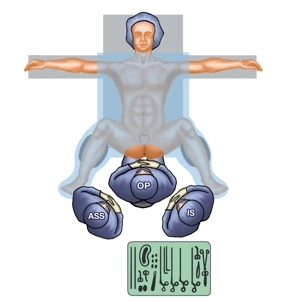- Except for small, insular, perianal condyloma clusters, the diagnosis of perianal and intra-anal condyloma mandates total surgical excision.
-
Indications
-
Contraindications
- The sole contraindication is for seriously ill moribund patients. In florid local inflammation (e.g., abscess), the procedure should be postponed until the infection has cleared.
-
Diagnostic work-up
- Proctological examination: Inspection, palpation, proctoscopy, rectoscopy
- If malignant transformation and infiltration are suspected, biopsy first and then follow up with appropriate diagnostic measures
-
Special preparation
- None, some cases may require cleansing or emptying of the rectum
-
Informed consent
- Recurrence
- Local wound healing problems
- Bleeding
- In extensive findings cosmetically vexing changes of the anal region possible
- Impaired skin sensitivity
-
Anesthesia
- General anesthesia (General anesthesia),
- Regional anesthesia (Epidural anesthesia, Caudal block)
- In special cases also local anesthesia
-
Positioning
![Positioning]()
With corresponding exposure of the anal region:
- Lithotomy position (predominantly in Germany)
- Prone
- Left-lateral recumbent
-
Operating room setup
![Operating room setup]()
- The surgeon sits facing the patient in the lithotomy position, with the first assistant to his/her left. The scrub nurse on the right side behind the surgeon.
-
Special instruments and fixation systems
- Anal retractor/ -locker (Parks anal retractor recommended)
- Standard proctology instrument set
- Small and large electric snare, ball-tipped diathermy
-
Postoperative management
Postoperative analgesia:
Nonsteroidal anti-inflammatory drugs usually sufficeFollow this link to PROSPECT (Procedures Specific Postoperative Pain Management)
Follow this link to the International Guideline Library.
Postoperative care: Postoperatively close follow-up visits are recommended in the first three months (e.g., every four weeks), subsequently at longer intervals.
Deep venous thrombosis prophylaxis:
Unless contraindicated, the moderate risk of thromboembolism (surgical operating time > 30 min) calls for prophylactic physical measures and low-molecular-weight heparin, possibly adapted to weight or dispositional risk, until full ambulation is reached.Note: Renal function, HIT II (history, platelet check)
Follow this link to the International Guideline Library.
Ambulation:Immediate mobilization
Physical therapy: Not necessary
Diet: Unrestricted
Bowel movement:No intervention
Return to work: depending on severity a few days to 2 weeks


